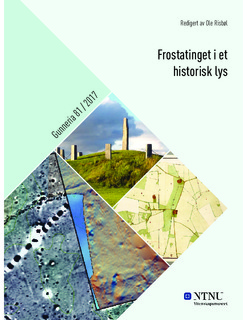| dc.description.abstract | On the Frosta peninsula, centrally located in the Trondheimsfjord-area in midNorway,
the annual Frostathing law assembly was held for several centuries
starting somewhere during the Iron Age (most probably during the end of the
Viking-age period), and until the last thing-assembly in mid-16th century. In the
assembly’s prime years and at least until the 15th century, a minimum of 485
men assembled here each year as local representatives from smaller thing areas.
Sadly, this activity has left few traces in the landscape. This project was therefore
initiated to perform a detailed archaeological study of the landscape at Frosta, to
answer the following research questions: 1. What cultural historical information
is available, and what does it tell us of the landscape and the thing-assemblies
organised here? 2. How can geophysical methods contribute to increase the
available knowledge of the area, by identifying and investigating structures
and traces in the landscape relating to the thing-assemblies? To answer these
questions, a detailed study of possible locational factors, antiquarian and historical
sources such as old travel reports, statements and place names, as well as known
archaeological sites and monuments was initiated. This work includes analysis of
old maps, known sites and monuments, analysis of aerial photos and cropmarks,
as well as geophysical surveys. The result of this work is a detailed overview of
past activities in the landscape, where several hitherto unknown burial mounds
were identified and settlement-areas were delimited. The possible presence of an
Iron Age cooking-pit field, indicated by cropmarks, was also rejected. While new
information led to improved knowledge of the thing-landscape, any traces which
could be directly interpreted as deriving from the thing-assemblies themselves
were not found. However, the analysis did help delineate areas within the
landscape in which the assemblies were probably held | nb_NO |

